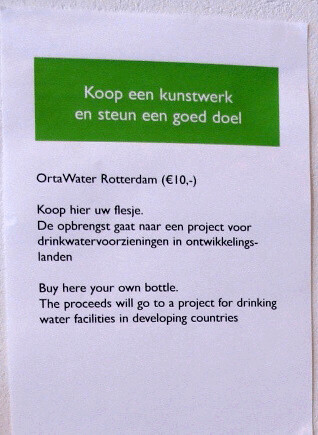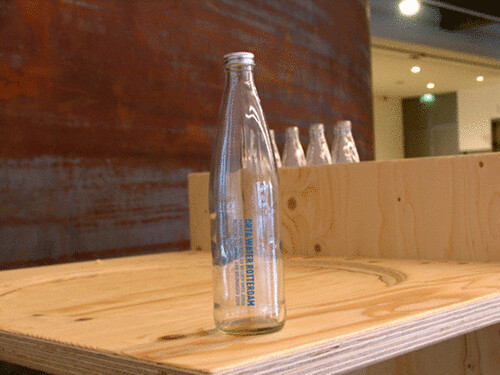Friday, February 17, 2006
buy an art work and support a good aim
The machine translation of the text in Dutch at the top of this sign is buy an art work and support a good aim ... It's from the Lucy & Jorge Orta show at Boijmans - here,
The show finished on the 5th of February, but I have been thinking about this show for a few weeks now and trying to figure out why it bugged me so much. My first thoughts were that the show is an expression of a kind of anxiety that art institutions have, and that artists have, about the relevance of their practise. In the face of problems like the lack of clean drinking water in the third world, contemporary art and it’s institutions can seem fairly irrelevant. But I ask myself all the time whether this feeling of … irrelevance, or helplessness, or impotence … can be addressed by taking ‘an issue’ as the subject of the work that you make.
My second thoughts were that the problems of the third world are pretty much related to the development of capitalism, so it seems a little short sighted to try and remedy these problems by selling something in a museum. The idea that you can alleviate the effects of capitalism by buying more things, instead of attempting to modify your own behaviour. The installation doesn’t address the distribution of funds raised by the sale of the bottles of water. For example, what are the museum’s administration costs, and how much does it cost to produce the bottles? What are the costs of sending the money out of the country?
Related to this was something I heard on the radio a few months ago about the environmental cost of building or renovating a home or a new building. The information I remember is that the environmental cost of carpeting a floor of a building was equivalent to filling the same space with water 10 times. That’s just the cost in water, you can add all the other raw materials, electricity etc on to that. So, what’s the environmental cost of producing a single bottle made from clear glass? Is this equivalent to filling the bottle ten times over and then emptying it down the drain? What is the environmental footprint of a contemporary art exhibition?
The show finished on the 5th of February, but I have been thinking about this show for a few weeks now and trying to figure out why it bugged me so much. My first thoughts were that the show is an expression of a kind of anxiety that art institutions have, and that artists have, about the relevance of their practise. In the face of problems like the lack of clean drinking water in the third world, contemporary art and it’s institutions can seem fairly irrelevant. But I ask myself all the time whether this feeling of … irrelevance, or helplessness, or impotence … can be addressed by taking ‘an issue’ as the subject of the work that you make.
My second thoughts were that the problems of the third world are pretty much related to the development of capitalism, so it seems a little short sighted to try and remedy these problems by selling something in a museum. The idea that you can alleviate the effects of capitalism by buying more things, instead of attempting to modify your own behaviour. The installation doesn’t address the distribution of funds raised by the sale of the bottles of water. For example, what are the museum’s administration costs, and how much does it cost to produce the bottles? What are the costs of sending the money out of the country?
Related to this was something I heard on the radio a few months ago about the environmental cost of building or renovating a home or a new building. The information I remember is that the environmental cost of carpeting a floor of a building was equivalent to filling the same space with water 10 times. That’s just the cost in water, you can add all the other raw materials, electricity etc on to that. So, what’s the environmental cost of producing a single bottle made from clear glass? Is this equivalent to filling the bottle ten times over and then emptying it down the drain? What is the environmental footprint of a contemporary art exhibition?
Making work ‘about something’ doesn’t really avoid the fact that art is always about aesthetics. And isn’t aesthetics a set of rules or conventions about how things are done in a certain situation or context? Not so much a language game as a highly specialised form of charades? So we have highly developed conventions for making a work that explodes the white cube, or making work that addresses the separation between art and life, or making work that questions the differentiation between high and low culture, and making work that addresses the issue of “x” … we have conventions for challenging conventions.

